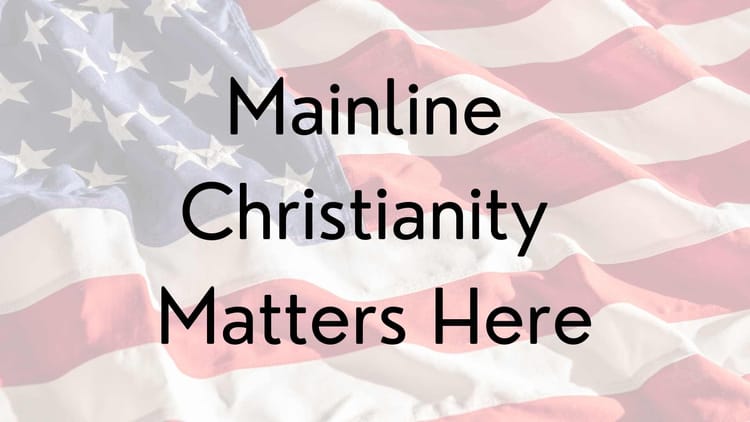A Million Dollars + The Internet = Episcopal Renewal

This post is a response to the latest Acts 8 Moment BLOGFORCE challenge: “If you had a million dollars to help “proclaim resurrection in the Episcopal Church,” where would it go and why?”
Let’s get some obvious points out of the way before we start spending that money:
- If I spent a million dollars on my local congregation, it would have a huge impact. Why? Our operating budget is about half a million dollars, and we just started our still-small endowment (which is why you don’t see anyone from St. Andrew’s, Grand Rapids at the CEEP conferences.). A million dollars coming into my local church’s system would be a huge change. (And we’re one of the largest churches in our diocese, which should give those of you on the coasts a good picture of the rural areas in Province V.)
- If I spent a million dollars on our diocese, it would have a smaller but still significant impact. Our diocese has about a million dollar annual budget. Another million dollars in revenue — especially with the mandate to spend it now rather than build up our fairly small endowment — would be pretty exciting, essentially doubling our annual revenue stream.
- But adding that million dollars to the revenue stream of the churchwide budget is the equivalent of a drop in the bucket. The current triennial budget is more than $100 million dollars, and covers a vast variety of territory – from English-speaking dioceses with “first world” challenges to Spanish and Chinese-speaking dioceses with different opportunities. A million dollars has to be used very carefully to leverage change in such a large system. (This is why I think we need to allocate more than a million dollars for new congregations – it’s just not enough money to make a huge difference in the vast and diverse Episcopal landscape. A million dollars just for youth and another million dollars for young adult ministry sounds about right to me, however..)
So, the first question to address in this BLOGFORCE challenge is: at what level will this million dollars be spent?
Since it’s my blog post, I’m going to spread the wealth. Half of my million dollars will go to the churchwide budget, a quarter to my diocese and a quarter to my church. This means I have even bigger challenges at the churchwide level, as I am allocating less than .5% of the current budget. (Next time we need a BLOGFORCE for $10 million!)
At the churchwide level:
1. For about $40,000, I would buy every active Bishop and all diocesan Congregational Development-related staff two books (approx. 1000 sets at $40/set.) These two books are Crisis and Renewal: Meeting the Challenge of Organizational Change (Management of Innovation and Change) by David K. Hurst and Toward the Better Country: Church Closure and Resurrection by L. Gail Irwin.
The first book provides an ecological model for organizational renewal along with examples from a variety of sectors. The second provides a deeply faithful, Scriptural, and practical guide to thinking through options for unsustainable congregations. Hopefully the recipients of the books would be so moved by them that they would find time to discuss them at their regular gatherings and via their current online communities.
I might also buy Gail Irwin’s book for every vestry of every church with fewer than 15 people attending weekly, but I’m not quite sure how many of those there are, which leads me to…
2. I would create a better method for gathering, reporting, and sharing data. This method would focus on three key metrics. No, those metrics do not include average Sunday attendance and plate/pledge income!
There are two problems with ASA and plate/pledge as our key metrics.
First problem: ASA and plate/pledge are lagging indicators, not leading indicators. If other things are going well, eventually attendance and giving will go well also. But eventually is a key word there; it can take a long time for ASA and plate/pledge to reflect change. Focusing on these metrics is like having an ICU nurse focus on whether a patient’s eyes are blinking rather than tracking the patient’s heartbeat.
Second problem: ASA and plate/pledge promote a spirit of competition among churches, which is sin. All of us are the body of Christ. When one church feels inferior or superior to another over ASA or plate/pledge, Jesus weeps.
And yet our entire system is set up to reinforce the idea that we measure ASA and plate/pledge. Just go look at the Research and Statistics page. I’m willing to bet that our staff in this area knows better, but do they have the funds to create an entirely new system? Probably not. Let’s change that!
What we need is a system for data collection which accurately tracks leading indicators in a timely manner and promotes the unity of the body of Christ. The key metrics are:
- number of first-time visitors (which we currently track nowhere in our official Episcopal system);
- number of adult baptisms (a statistic which is buried in the parochial report and never made public);
- percentage of Episcopalians per county (which the Association of Religion Data Archives tracks once a decade, and the church tracks nowhere at all).
Why these three metrics? Because the first two are leading indicators of church sustainability, both practically (no visitors eventually means no new members) and spiritually (adult baptisms happen when we fulfill Christ’s call to make disciples). And the last is the metric we need to get churches thinking of one another as companions, not competitors. Isn’t that what Christ and the Episcopal tradition teach?
This new system needs to allow for immediate data reporting and analysis. It is insane that in 2014, the official method for church data collection is for a person to write with a pen in a little book which is totaled and sent in to our churchwide headquarters ONCE A YEAR. That is insane.
I understand that there are churches which are wealthy enough and prioritize data enough to pay for ACS or a similar system. But there are also churches who believe outreach may be a better use of their money, or paying their rector, or many other reasonable expenses. In an era characterized by numeric decline, where we need nothing more than to figure out how to invite and welcome (ahem, evangelize) the newcomer, why have we not created a system which provides information about what is working where, in a timely fashion?
Churches and dioceses could participate in it on a voluntary basis – we don’t have to mandate it. If it were well designed and reliable, they would want to use it! And I bet it wouldn’t even cost a million dollars. We could hire the work out to Domo or a similar business. Let’s benchmark this one at $160K.
3. I would also create an online community for Episcopalian families to discover and share faith practices in the home. I had high hopes of doing this myself in my spare time after I went to the e-Form conference earlier this year, but the up-front costs in terms of both money and time have just been too high. The closest thing to what I am imagining is the Vibrant Faith at Home site, which gets better all the time. But I would love something that is specific to the Episcopal Church, passes on our traditions and connects families to one another across churches and dioceses.
If we could build an online community using a tool like Ning or NationBuilder or a customized tool, we would support families in their journeys of faith and assist in raising up a generation of Episcopalians. I’d sleep better at night if I thought the future would contain faithful mainline Christians who could proclaim the gospel and serve those in need in Christ’s name. Families need support to grow as Christians, and the wider culture isn’t providing it. I’ll benchmark this project at another $100K which would pay bloggers to write for it and an editor to manage and grow it.
4. I would also create a Bishop Search Manual. Here’s another project I’ve wanted to do in my spare time! When I was on the bishop search team, we received an out-of-date binder. Here’s an example of the contents:
Bishop search teams are entirely dependent on their consultants, who access a set of documents in the cloud (or don’t) to provide resources for search teams. This means that the consultants necessarily function as gatekeepers, which is not in the best interests of the process. We should have a standardized guide to the nuts and bolts of this process so each search team doesn’t have to reinvent the wheel. Simple things like how to manage the multiple files received electronically are no-brainers once you figure them out, but at this point every team is probably developing their own unique solution because there is no standard guidance. The binder our team received in 2012 was created in the pre-Internet age. Need I say more?
The biggest cost for this would be someone’s time. To do a really good job that would be authorized by the church would probably cost at least $100K. It would include short online videos about the role and purpose of the episcopacy that could be used for education as well as hints and tips for managing the search process. The type of totally unauthorized guide I have had in mind could be done for more like $10K. Since we’re dreaming our best on behalf of the whole church here I’ll go with the higher figure.
In terms of raising up leadership for the future, nothing is more important than our bishop search process. In that process, nothing is more important than ensuring the teams of people charged with the work have the resources they need to do it well.
5. And, while we’re creating resources for the church, let’s make a specialized crowdfunding platform for Episcopalians. Such things do exist! The Unitarian Universalist Association has Faithify, and there are now many platforms that enable anyone to set up their own specialized crowdfunding site. Direct costs for the site would be $25K per year, but we will need a full-time person monitoring and publicizing the opportunities, so we can generously fund this at $100K as well just to keep it in the round numbers.
We’ve only spent half a million dollars and we’ve created huge benefit for the church by leveraging the Internet for ministry. I’m going to pretend that other sources will fund the ongoing expenses for the new online ministries so I can keep the other half million dollars for my diocese and congregation.
In my diocese…
1. I would pay a full-time salary and benefits for our young adult missioner. He’s currently funded at a half-time position without benefits, because he’s on a mission from God and willing to work for that amount of money. Even though he’s probably doing among the most mission-critical, risky, strategic, pioneering work in our diocese. We can benchmark 50K to add to what he already makes.
2. I would also pay a full-time salary and benefits for the rector of our diocese’s Sudanese congregation. Yesterday at our convention we heard about how he has to work a secular job in addition to ministering to his people to make ends meet. His life has been so difficult and his ministry so fruitful that he has been the subject of a documentary and made the New York Times, but he can’t make a living as a priest because his congregation of mostly refugees can’t pay a full salary (and we need to review our diocesan policies on mission churches, but that’s another story). We’ll benchmark another $50K for him, add in the $40K he is seeking to create a medical clinic in his home village in South Sudan, plus another $10K for his church to pay their Christian educator more than 5 hours per week. That gets us to another $100K for that ministry.
3. And, in my diocese, I would fund the start-up of the farm-based ministry I have been dreaming about for more than a decade.
If I had $100K for this ministry, I would be able to pay a farmer’s salary and pay myself to focus on organizing this start-up rather than squeezing it in along with my (too many) other projects that make a difference but no money.
My vision is for a project which incorporates elements from The Abundant Table (the closest Episcopal equivalent), Adamah Farm and the Food Project. The aim is to inspire and educate youth and young adults through engagement in the practices of sustainable agriculture and Christian spiritual formation.
I am working on this, but slowly – a cash infusion would help me work more quickly. (You’ll be hearing more about this project in the coming months as I turn more attention toward it – which hopefully will lead to funding!)
In my church…
The quarter-million for our local congregation is easy, because we’re running a capital campaign… and we’ve been waiting for that one big check.
How would you spend a million dollars for the Episcopal Church to be able to serve the mission of God more fully?
Anybody want to fund any of the ideas above? I’d love to hear from you!





Member discussion